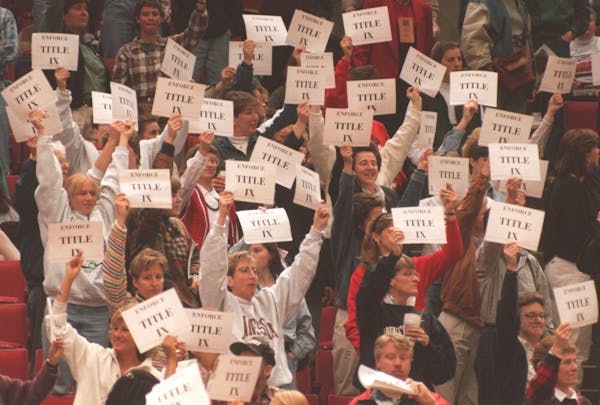
My introduction to working in a sports department came as a 17-year-old copy boy at the Minneapolis Morning Tribune in August 1963 and I have been employed in such an environment ever since.
The most dramatic and sports-world-changing event of those six decades occurred in 1972, and its 50th anniversary will be marked by the Star Tribune and hundreds of other media outlets throughout 2022.
And unlike Jackie Robinson being signed by the Brooklyn Dodgers on Oct. 23, 1945, with an eye toward integrating Major League Baseball, it took much longer to understand the seismic change in sports that would occur after President Richard Nixon signed into law Title IX of the Education Amendments on June 23, 1972.
There was no specific mention of athletics in these amendments that prohibited discrimination based on sex for all educational activities that received funding from the federal government. It would be a couple of months before it became clear gender equity would include sports.
I was in the midst of a three-year run as a young and unprepared assistant sports editor for the St. Paul Pioneer Press when this took place. Already there was movement toward providing athletic opportunities beyond intramural for Minnesota high school girls, but there was also little anxiety that this would create an added coverage burden for our all-male sports staff at the St. Paul newspapers.
After all, when the Minnesota State High School League announced the hiring of Dorothy McIntyre on July 1, 1970, to oversee the development of a girls athletic program in some form within the state, the league's monthly bulletin included the following:
"We believe [McIntyre] will be patient and understanding in our attempt to find the proper place for girls in the competitive sports program, at the same time being extremely careful to preserve and ever improve girls physical education, extramural and intramural.''
About this series
50th anniversary of Title IX: More than a celebration

Ah, yes, the "proper place" for girls' and women's team sports. That was still the dream of male sports administrators … and perhaps young assistant sports editors.
This past Sunday, I was driving from Golden Valley to Woodbury to attend an 8 a.m. hockey game that included my granddaughter's 12-U team, and the two rhetorical questions that I've been asking myself for decades occurred to me again:
1. How did we as American manhood get away with — until the last quarter of the 20th Century — the idea that slightly more than half of our population should be satisfied to perform as cheerleaders or band members, and run around a gym for 45 minutes a day in phy-ed classes, while boys had access, coaching and schedules for multiple sports?
2. Once girls' team sports arrived, how obtuse were we to expect instant refinement of skills as girls and women finally started to get access, coaching and schedules for multiple sports in the mid-'70s?
As for Question 1, there's information out there that's mind-numbing: There was a state swimming meet for girls with significant participation through 1942, and then it disappeared and didn't come back until 1975. There was a statewide program for girls' basketball from the early 1900s into the early '40s, with no official state tournament, and then those programs also disappeared.
There are a couple of photos floating around of my mother, Cecile Reusse, from Waldorf, Minnesota's McDonough clan, in a basketball uniform in the 1920s. Of course, it never occurred to me to ask about her basketball exploits before she died too young.
In the early 1940s, America put together a women's workforce to build the airplanes and other war materials to defeat Nazi Germany and imperial Japan in World War II, and then we spent the next three decades worrying girls would overstrain themselves facing other high school teams on courts, in pools or on tracks.
As for Question 2, there is no claim here of early enlightenment. Once girls competition started, I was among those sitting in Luigi's Bar near closing time on winter nights, saying, "That girls game tonight must have had 25 jump balls."
And we boys working in sports, we fretted for years as to when the first women's college player was going to be able to dunk. How moronic was that?
Not quite as moronic as my observation in a "notes'" column printed on March 2, 1991. I was at the Star Tribune by then and threw out a series of opinions. One concerned a couple of poor basketball games — one high school game, one in junior college — witnessed that week. I suggested surprise that women's basketball had not improved to a higher degree. The phrase I used to describe what I had seen was "tip-toed ball throwing."
This turned out to be an excellent moment in my career. One, through the kindness of editors and a printed apology, I survived the outrage that followed. Two, it provided the impetus to look closer and thus gain a genuine appreciation for women's team sports.
If that alone didn't convert me, then interviewing Heidi Olhausen and Kate Callahan, a Lakeville duo with the Gophers volleyball team, did so in the fall of 1992. They were high entertainment and part of the reason Gophers volleyball was good then.
Then it became exceptional with Mike Hebert as coach, and now Gophers volleyball is annually the most entertaining sport on campus with Hugh McCutcheon.
If the crash course in volleyball didn't allow me to find religion on this issue, there was perhaps the most delightful and fierce collection of competitors we've seen as Gophers since … well, that '60 football team that beat Iowa and went to the first Rose Bowl. I'm talking the 2003-04 Gophers, the Final Four team: Whalen and McCarville, Schonrock and Bolden, Andersson and Roysland, and the frosh, Broback and Podominick.
I'm not sure of McCarville's religious background, but if confession is part of it, I hope Janel mentioned what she did physically to poor, lean Nicole Ohlde of Kansas State in that 80-61 second-round game in front of nearly 14,000 at Williams Arena.
And if none of the above qualifies as conversion on the wonders of Title IX and its impact on America's sports — on our way of life, really — there's seeing 12-year-old girls early on a Sunday morning, skating and stickhandling and seeing teammates while on the move in a manner totally unrecognizable from what was the case only one winter earlier.
Guess what? Athletes, girls or boys, get better with time spent playing and being coached. I should have thought of that 40-some years ago at Luigi's, and passed on complaining about all the jump balls.
Now we get the Women's Final Four in Minneapolis, and here's hope UConn will be healthy and back in the field, and Iowa will make an upset run, and we would get to see Paige Bueckers vs. Caitlin Clark. That would be something extra special to celebrate 50 years later.
. . .
Title IX at 50
An occasional Star Tribune series on the pursuit of gender equity in Minnesota sports
Read about our new series on Title IX's 50th anniversary here.


